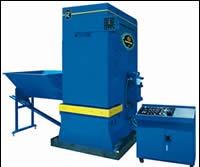Chip Compactor Squeezes Out Savings
Kurt Manufacturing Company (Minneapolis, Minnesota), learning from experience, believes it has developed a highly efficient recycling system that produces significant savings.
As shops contend with the disposal of scrap and coolant, they can easily fall into the trap of what appears to be the easy way out. As chips quickly accumulate, getting rid of them becomes a top priority. The faster the scrap dealers can get the chips out, the better. However, often little thought is given to ways to make the most of the scrap.
Kurt Manufacturing Company (Minneapolis, Minnesota), learning from experience, believes it has developed a highly efficient recycling system that produces significant savings. William Kuban, CEO, reports, “Five years ago, we were using coolant costing $16,000 a month for a precision machining job of a large heat sink component. We weren’t recycling any of the coolant. Also, we were handling chips in the traditional way by selling them to scrap dealers as they accumulated in drums with much of the coolant mixed in with the chips. It suddenly dawned on us that between the chips and coolant, we were ‘giving away’ a lot of money. That’s when the idea for our Chipmunk Compactor/Briquetter was born.”
Because the company’s machining operations were seeing huge cost giveaways for both aluminum scrap and coolant, it developed the Model 1200 Chipmunk compactor. The system is designed to compact both ferrous and nonferrous chips and reclaim expensive cutting fluids. The Chipmunk system now provides $180-per-hour higher profit yield for the compacted chips versus not compacting them. The company also cut its coolant costs in half on that heat sink machining job. It saves $8,000 a month alone in coolant costs by compacting the chips and, in the process, recovering a significant amount of the coolant, which is filtered and reused. They transform metalworking chips into dense and dry briquettes, increasing the amount of fluids reclaimed and eliminating the need for the typically large areas required for scrap storage.
No Ordinary Compactor
The compactor can provide a shop with new methods for precision machining cost savings and better manufacturing practices. The design concept is based on more than a high-profit return for a small investment. According to Mr. Kuban, “The Chipmunk is designed to be a major conservation device as well as machine profit center. The system compacts up to 500 pounds of aluminum chips an hour and up to 1,400 pounds per hour of steel and ductile iron. It can produce an average of $180 more an hour when compared to chips that are not compacted.” Combining this savings with that from coolant recovery can total as much as $250 an hour. The conservation benefits are big, too. Material is saved, coolant is saved and floor space for storing and handling scrap and coolant is saved. The shop is neater and cleaner, too. Most important, machine operators develop a new attitude toward scrap and material conservation.
Large And Small Operations
The company made a special effort to provide a product that not only suited its needs, but also would be useful to other organizations as well. Throughout the 5-year development period, Kurt worked with leading precision machining companies to develop a system that would perform well and produce high returns. “The engineering challenges were many, but the Chipmunk is truly a system designed and built with the user’s needs in mind,” Mr. Kuban says. “Early users, in effect, became part of our design team, suggesting refinements to the system. As such, the Chipmunk can be equated as another profit-producing machine like a machining center or a milling machine. In many ways, the Model 1200 Chipmunk compactor allows the user to turn scrap and recovered coolant into immediate profit at a rate equaling and even exceeding the productivity of the best machining centers.”
The system produces dense aluminum chips. The Chipmunk’s 8-to-1 compaction ratio brings relatively high market prices from scrap dealers. Also, the system uses a kinetic energy design to economically deliver power from the 30-hp main motor. The high compacting force increases the amount of coolant reclaimed from the chips, increasing overall savings. The dense, consistent briquettes promote market-value pricing because they are easy to work with and facilitate accurate weighing.
The compacting system is designed for high volume, although the compact footprint makes it practical for both small and large-scale chip-producing operations. Other design features include straight line, single auger feeding for non-clogging operation; simple compression plate, punch and die design that consistently compacts chips; an automatic discharge chute of compacted briquettes (no moving parts to jam up); a programmable logic controller that allows manual or automatic operation; and simple change-over from one material to another.
Read Next
Laser Simplifies Form Tool Chip Control
The creation of a 'bird nest' is a problem for any turning operation. These uncontrolled wads of chips tend to wreck havoc on tooling, equipment and continuous operations.
Read MoreA Tooling Workshop Worth a Visit
Marubeni Citizen-Cincom’s tooling and accessory workshop offers a chance to learn more about ancillary devices that can boost machining efficiency and capability.
Read MoreEmerging Leaders Nominations Now Open
Here’s your chance to highlight a young person in your manufacturing business who is on the path to be a future leader moving your company forward.
Read More





















.png;maxWidth=970;quality=90)